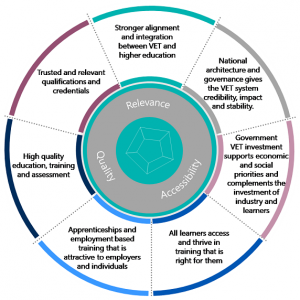VET Insights
The Government is committed to improving Australia’s skills systems and the vocational education and training (VET) sector. Over the past couple of years they have been inviting feedback from industry and other stakeholders on the ways VET can be improved. They have drafted a VET Reform Roadmap, launched the Delivering Skills for Today and Tomorrow package and more recently established the skillsreform.gov.au website to collect and report on feedback on a range of VET topics.
These initiatives recognise that we can all contribute to change and be part of a better solution for the VET sector.
Documented on this webpage are some insights collected as part of our work with IRCs and VET stakeholders that we interact with on a regular basis. We share these insights to support and provide input into the governments’ VET reform processes. We encourage you to read through some of the issues and potential solutions highlighted here and we welcome any further input you have.
The information has been gathered through our extensive interaction with industry, training providers and other stakeholders in the VET system over the past five years. These stakeholders have shared with us lots of ideas for how VET can be improved. They have shared their concerns and challenges and talked about possible solutions to these. We are collecting this information and undertaking further research to provide input to the governments’ VET reform processes. Our research includes both qualitative and quantitative approaches, including literature reviews, interviews and discussions with industry and VET stakeholders, data analysis, and surveys.
We have assembled the feedback and ideas under six categories, as described below.
Industry Leadership
Industry has a leadership role at the beginning of the skills pipeline, to describe their skills requirements. However, they have very little input over what, how and when training is delivered. Increasing industry leadership would have industry involved, in a structured way, at all stages of the system.
Read more.
Competency is a Journey
Competency is more than completion of a training course and it is best achieved through a combination of workplace and institutionalised practice. Our research shows that many VET sector stakeholders believe a staged approach to competency development would be a realistic improvement to the current competent or not yet competent dichotomy.
Read more.
Units Supported by Curriculum
Units of competency and qualifications are what currently make up ‘training packages’, but they by themselves do not make up a complete package of training. They define occupational outcomes and include a range of knowledge and assessment requirements, but they do not describe the training activities that needs to take place. It is pleasing to see the government is exploring the options to add training standards into the VET system, perhaps even into training packages.
Read more.
Thin Markets and RTO Delivery Challenges
The training delivery market struggles to operate in high cost and thin markets with serious consequence for a number of industries and occupations. Thin, high cost markets exist where there are low student numbers or learners are spread across large geographical areas, where there is access and safety issues, and/or the training is for highly technical skills, and/or a need to use expensive materials and machinery.
Read more.
Contextualisation of Units
There are more than 15,000 units in the VET system, despite efforts to reduce them. The high number of units are partly a reflection of the diversity of skills as new units have been progressively developed over the past decade to reflect new ways of work, but older methods are still used and require training. Units describing the same skills also exist, but with details specific to a particular industry. National contextualisation materials could help reduce the number of units in the system.
Read more.
Skills Acquisition is a National Economic/Social Imperative
VET sector training hours represents less than 2% of hours worked across the economy each year. This is a lot, but clearly only a small contribution to the amount of learning that takes place while working. Industry stakeholders would be helped if Australia’s skills system could recognise the quality and extent of learning taking place in the workforce, which is estimated to be between 2 and 10 times the volume of VET, and ways to capture data about it.
Read more.
CEO Michael Hartman explains how the issues and solutions presented on this VET Insights section of our website are aligned to the outcomes and goals of the current reform processes, and how they have been developed from our extensive interaction with industry and the VET sector over the past 5 years.

The issues explored in these categories relate to the three priority areas of the draft VET Reform Roadmap around Relevance. Quality. Accessibility. Our work with stakeholders unpacks these issues and suggests solutions in key areas of impact, with the aim to support the Governments’ VET reform processes.
Your Input is Welcome
Contact us with any questions or to share your thoughts.
Griffith University Research
Skills Impact took some ideas for VET system improvement that our IRCs and stakeholders have shared with us and asked Griffith University to compile a short, anonymous survey to help test whether the issues are important enough to be considered by VET policy makers.
Thank you to everybody that took part in this survey. Over 550 responses were received.
Griffith University have analysed the data and produced a report titled ‘A focus on learning: Balancing outcomes and development in Australian Vocational Education and Training’.
Subscribe to updatesSubscribe to the Skills Impact newsletter to keep informed about updates and opportunities to provide input. |

